A short while ago I wrote an article (here) about DIY gaming and how making your scenarios, armies, rules or entire games is a magnificent use of your time and creativity. The indie RPG and tabletop scenes are absolutely flourishing right now so I wanted to take a moment to highlight a particularly interesting game that has just launched its Kickstarter.
Relicblade, a tactical fantasy adventure game created by Sean Sutter. I had a chance to conduct a meandering interview with Sean where he discusses everything from his gaming history, the benefits of sculpting digitally and the importance of incredibly dangerous battlefield conditions, but first a quick review of the game itself.
Relicblade is a small sided skirmish game fought between heroes (currently a Knight, Druid and Cleric) and monsters (the dreaded pig-men). This gives a scaled down version of elite vs. horde nature of many games, with blunt force of numbers on the pig-men side and the finesse of the heroes. The recommended wargame size can have as few as 3-5 figures per side and a game can easily be completed in under an hour. Statistics, abilities and upgrades are all contained on cards which minimizes the use of the rather compact rulebook during the game. Illustrated in an endearing comic-book style, the rulebook itself is a fun read that gets you excited about the adventures to come. Sized and bound like a comic book, I really can’t adequately explain the personality and delight that pours out of it. The hand drawn diagrams, table layouts and card components show this to be a labor of love. Even the shipping box had a cool illustration. The basic game features a powerful (but random) relic in the center of the table for both sides to fight over. Once you’ve learned the basics the game moves quickly with just the figures and the cards out on the table.
The gameplay is absolutely fast and brutal. Each model has a number of action dice they can spend on moving, fighting, spells or special abilities. This means there is incredible flexibility on what a figure can do in a turn. A bestial berserker pig can use all movement actions and sprint across the battlefield to get stuck in. The druid, in one activation, might throw out devastating spells and attacks before assuming a defensive posture to protect from incoming aggression. Characters can climb, leap across gaps, change form, wield spirit weapons and protect fallen comrades giving incredible scope for narrative gameplay and exciting tabletop moments.
I was able to run through a handful of test games and dear fucking lord things get savagely violent quickly. There is an initial phase of dashing towards the middle in order to secure (or at least contest) the relic, as just giving it up for no gain can be a sucker move, and then it becomes a mosh pit of ass kicking. Because the same action dice are used for movement, abilities and attacks, there is a bit of cat and mouse about engaging as moving in close to fight exposes you to the full dice pool of your opponents figure in the following activation. This is dealt with by giving the charging figure a bonus dice as they come barreling in, encouraging aggressive and decisive action.
The battlefield for the game is intentionally tiny. A two foot square that should be densely packed with the most cinematic terrain you can muster. This game really benefits from a cool battlefield with interesting environmental challenges. I placed the relic on top of a multi-storied, multi-entranced building complex that allowed for some creative assaults (including a fucking 2 story dive bomb by a bear). Incredibly compelling stuff just happens in this game. A berserker pig raged, harming himself for more actions, used those actions to beat the cleric into a pulp and finished by devouring the poor guy to gain the health back. Absolute carnage.
The miniatures themselves are stylish and look to paint up nicely. The pig-men are an entertaining variation on beastmen and make for a delightful foil. The heroes, especially the cleric and druid, represent a charming departure from the mundane. The game is quick, bloody, allows for storytelling and cinematic moments and requires a minimal investment of time and money. I’ve really enjoyed my initial games and look forward to what is coming in the future.
So enough from me, let’s hear from the guy himself Sean Sutter.
Brinton: So tell us a little about yourself. How’d you get into gaming? Brief history of what you’ve played and how it affected you.
[Sean] My big brother was into D&D, so obviously I was into it too. I liked role-playing but the miniatures I saw down at the game store set my brain on fire. Once I could actually muster the money for a Warhammer starter set it was all over for me. I played 40k and Fantasy Battles the most but a couple years ago I started playing Warmachine, too. And that game really opened my eyes that miniatures games could be fun! Since then I’ve been playing as many different games as I can get my hands on.
So what made you want create your own game?
[Sean] How deep do we want to go? Probably the simple answer is that I’m an artist who is driven to create, and miniatures games are my favorite thing. I think most gamers like the idea of creating their own game. I’m a professional artist, and I realized that making a miniatures game achieves every goal I have for my art. So instead of investing thousands of dollars in a series of new paintings, I made a game.
What was the look and feel you were going for with the visuals of the game?
[Sean] I get to be myself with Relicblade. I don’t really need to conform, so the visuals are an extremely honest representation of me. It’s a little cool and a little goofy. I’m a professional comic book artist, so the style is comic. It’s a bit of fantasy vanilla with a lot of creative design space available.
Let’s talk about inspirations that really drive you as an artist? Feel free to name drop artists, music, games, nature or whatever you’re into. Could just be nature, or death, or just about anything.
[Sean] My biggest artistic influences are Mike Mignola and Chester Arnold. I’m really into Hellboy and especially the BPRD comics. The monsters and weird tales are spot on. Y’all are probably pretty familiar with why Mignola is amazing, but you may not be familiar with Chester Arnold. Chester Arnold is a bay area narrative painter who is mind blowing. His paintings are magnificent, vast, sprawling, and dark narratives told mostly with landscape. They’re remarkable in person. You’ll have to pardon me, I’m getting carried away in my imagination as I think about it.
Why is Relicblade special? In your own words what makes it different/better than other games out there?
[Sean] The game is small, quick to play, and easy to learn. But skirmish games aren’t anything new. Relicblade really shines in the way you get to control your characters. The core mechanics are simple, so you don’t get bogged down in rules, but you have a ton of flexibility in how you use your character. People get to play the characters with the dynamism of an RPG while enjoying the non-stop action of a battle game. The balance between simplicity and tactical depth came out really nice.
I’ve been able to introduce people of all ages to tabletop gaming with Relicblade. I’ve had people from age 10 to 65 play, and at the time they were focused on learning something new and seemed to have fun. But later they’ve come back and said they really want to play more. That is pretty cool. It’s easy for a game to be neat and have cool figures. But a game that is fun enough that people are chomping at the bit to play more seems pretty special. I really do think the fun factor is pretty high.
The book emphasizes using creative (and oftentimes extremely dangerous) terrain in battles. Why was that important to you?
[Sean] It’s an adventure game. If you want a fair fight on the field of honor there are games for that. But Indiana Jones doesn’t play there. Also! When I’m playing D&D I would hate to lose a hero, but Relicblade is littered with the bones of heroes! The half hour time investment isn’t wasted if a character dies in a delightfully cinematic way!
While a lot of games have been lowering their model count and the industry seems to be moving towards skirmish, RelicBlade uses forces that can be as low as 3-4 models. Tell me about your thinking on the size of the forces in the game.
[Sean] There are a couple reasons. I’m a war gamer. I’ve painted 50+ miniatures for a single unit of spearmen. But I don’t have the time or money to do that anymore. I also wanted to break down some of the serious barriers for people that are interested in playing a miniatures game. Buying a battle-box, or a Warhammer starter set seems super appealing, but later you find out that you don’t have even the start of a real army, and the units you got are technically the worst in the game. I’ve been through that countless times and I think players are wary of that. They should be! I want people to play the full-sized game right out of the gate. I don’t want them to play an un-fun un-balanced parody of a game in the introductory starter-set. Did that sound harsh? I just want people to enjoy playing games together. If my best friend only wants to get the three starting heroes because he likes bears, no matter what we can still play together even though I’m the type of player that will buy all the models and mess around with mixing new models into my war band.
2’x2′ makes for a pretty intimate battlefield compared to big battle games. What are some of the advantages of playing games that small in your opinion?
[Sean] Since you don’t need a whole garage set aside for a 4’x6′ table it fits the accessibility principle. The other advantage is actually creating a real “adventure” board. Building a super sick, highly detailed, game table is a manageable and enjoyable process on a 2’x2′ board. You can see pictures of the studio terrain I made. That’s what I’m talking about! You know you’ve dreamt up overly complicated game tables, well I’m inviting you to make it.
You do all the sculpting digitally I believe. How has that process gone? What were some of the advantages of sculpting that way vs. traditional putty sculpting? What are some of the headaches involved?
[Sean] I use ZBrush for all my sculpting. I love it. I’ve never been happier with a creative medium. The advantages are edibility, un-matched detail, and the fact that I don’t have to be a materials wizard like the professional traditional sculptors. The only headache is the cost of prototyping the figures. A standard infantry sized dude, say the knight for example, cost me $141 to prototype. I also ended up getting a few rapid-prototypes (test prints) too. So all together the knight cost well over $200 to get printed. I guess putty costs money, but not that much.
I just wouldn’t be able to compete if I had to use traditional medium. My traditional sculpts are pretty gross looking. But I’m completely creatively home when I use ZBrush.
You mention a few different times in the book how gaming should be fun, agreement should be sought about things like dispute resolution or finicky terrain. Have you run into problems at the table (in other games) about things like this in the past?
[Sean] I think we’ve all played games that got weird. So I just wanted to take a moment to address the fact that playing tabletop games is special because you actually get to interact with a real person, and have real fun, with real friends. If you just want to s*** on someone you should be playing Xbox.
Who has helped you along the way?
My wife, firstly. She has been supportive in a lot of ways, even though she still hasn’t played the game! I also got a lot of help from the guys at Privateer Press! I went up to Lock & Load last summer and spent the entire time looking over the shoulders of the sculptors there. I harassed them with questions, and got a ton of amazing advice on sculpting. I’ve also made connections with Harold Crossly of Clear Horizon Miniatures, and he’s happily answered my questions about actually running a miniatures company. Jason Fariclough, of Thunderchild Miniatures, too! The Indie Tabletop community is full of rad people. We’re all passionate gamers that love toy soldiers.
Tell me about the Kickstarter.
Well. I worked really hard on Relicblade, and it’s done. The rulebook is done, the cards are done, the miniatures are done. They’re all in production too! I did all that before I went to Kickstarter because I don’t really like the idea of asking people to invest in a game when it’s just notebooks and a few drawings. I’ve had a rulebook that’s just a word document and miniatures that are just 3D renders, so I know how remarkably distant that is from an actual game! So uh, anyway. I made it. But now I know I need more money to actually order more stock.
Why use that platform vs. releasing yourself?
[Sean] I did released it myself! But I could only get a really limited run on everything. The cards for example, are so expensive to print in low quantity that I get paid around fifty cents for each $15 deck I sell! That’s a little over a penny per illustration! I think people see Kickstarter as an opportunity to find new stuff, so if I’m just a little indie game floating in the vastness of the internet they might not hear about it. But a little campaign might get in front of more eyeballs, and if it funds I will be able to order more copies of the game. People will only really have to wait for the game components to print instead of wait for me to make them. Also, the campaign has the potential to set a foundation for the studio. If I have a little more seed money in the Metal King Studio coffers I can really start expanding the game.
Do you have a day job? Are you hoping RelicBlade will let you quit that or are you just committed to making this game on the side?
[Sean] This is my day job. I’ve been working full-time on Relicblade since July. I also draw a comic book called B-Squad, which is also on Kickstarter this month! If you back both Relicblade and B-Squad you’ll get an exclusive B-Squad themed Relic Card! I do other freelance illustration and take care of my 5 year old daughter. So Life is a crazy mess of all kinds of great stuff. I want Relicblade to be successful enough to grow and pay for groceries! But I’m also working on getting my name out there as a freelance sculptor.
What kind of music are you into?
[Sean] My favorite bands are mewithoutYou and Blue Sky Black Death. mewithoutYou for Aaron’s lyrical complexity and honesty. It has that same vast dark narrative quality I love so much about Chester Arnold’s work. And Blue Sky Black Death has that melodic wondering depth I really jam to while getting lost in my art.
How does music influence your gaming/art?
[Sean] It’s that wondering narrative I keep thinking back to. I’m creating something that people explore. I think I would particularly draw a philosophical connection between a musical performance and gaming. I’m a conductor of adventure. I’m looking to provoke people to interact with each other while they explore the world of Relicblade. When people paint my figures they collaborate with me and finish what I started, but the crowning moment is when they experience the game. Maybe it’s a bit tenuous. But I essentially jam the fantasy adventure chords, and if people are feeling it they get to pick it up and get lost in it.
——
I’ve given the barest of background details on the mechanics of the game. Sean has recorded a Kickstarter video describing the game and Ash over at Guerilla Miniature Games has done a walkthrough video of the rules as well. Watch them. Back the Kickstarter, have an awesome time.
Also, I didn’t get the chance to paint up more than a couple of the figures so there aren’t photos of my test games as I’d hate to show off bare lead. I’ll try and get some pictures up soon of my personal play sessions.

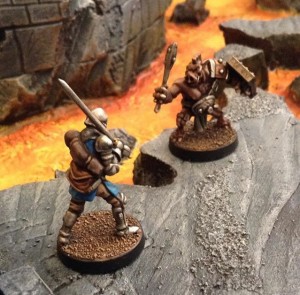
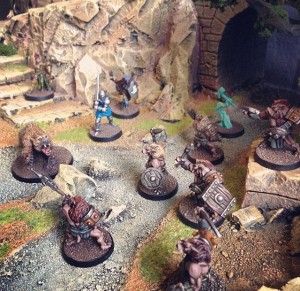
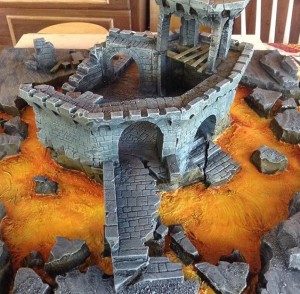
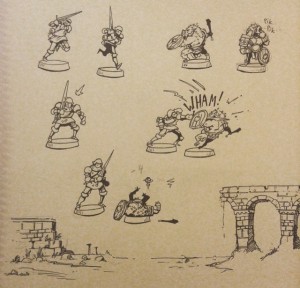
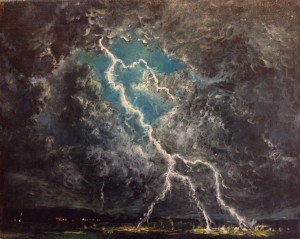
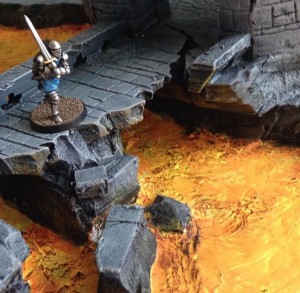
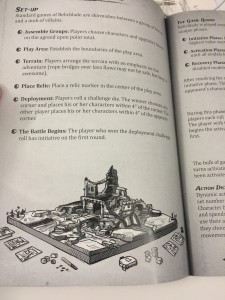
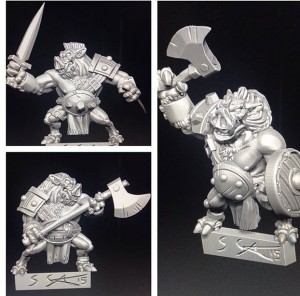
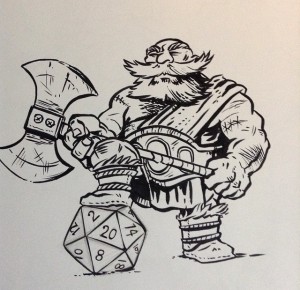
It looks brilliant, have to buy this game!!!